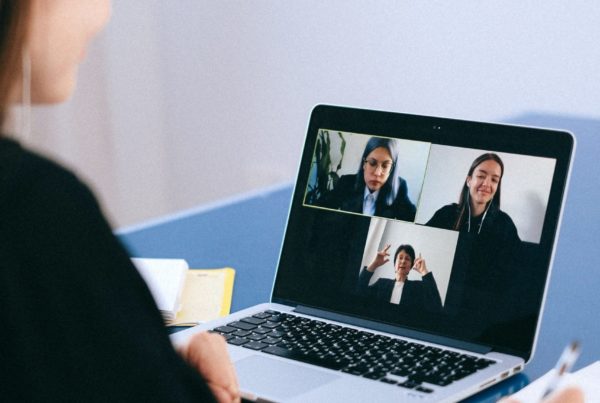
Winning New Logo Customers in an Uncertain World
Our virtual meet ups are designed to help Sales Leaders with the challenges and difficulties that come with the pandemic. This has since developed into a place for Sales Leaders to get support, share their experiences, and learn something from their peers in a more general sense, not just focusing on the affects the pandemic has had on the industry. The meet-ups are hosted by our MD & Founder, Paul Thomson, and joined by contributors to the meet ups, Calum Kilgour and John Bissett from Slingshot Edge. Together they have a wealth of experience in sales, managing sales teams, and being at the forefront of innovation.
We broached the subject of winning new logo customers last year when the shifting to an online working world was still new. Everyone was adjusting to it and learning how to make it work for their businesses. So, it was great to see so many fantastic Sales Leaders at the session who have got their processes down to a T! It was an eye-opening session that we’re sure everyone who attended will have learnt something or got inspiration to take something forward with their own sales teams.
As the topic ‘winning new logo customers’ is so broad, Paul started off the session by asking in a poll. What is everyone most interested in? What is everyone finding the most challenging? To which a collective 73% of the attendees said lead generation, and within that was a mix of outbound marketing and inbound marketing.
A few steps that our attendees have been taking towards winning new logo customers:
- Creating vertical packs that personalise their product or services to attract different industries.
- Switching up their website for a personalised experience.
Instead of focusing on the product or services, a more personalised experience focuses on how the organisation can help the buyer. - Projecting the business’ core values on social media and showing who they are, not what they’re selling. As one of attendees said “social media isn’t a marketplace, it’s a party. No one wants to be that person at a party who’s banging on about how great they are”. A brilliant analogy!
- Starting from the roots of the business and working your way upwards is a great way to get an understanding of the business – by working your way up, you can create strong working relationships with various people in the business, you begin understanding the business and its motivations better. The most basic human need in life is to be understood and people buy from people who understand them. So, by taking the time to understand your buyer’s business and getting people from all areas of the business on board, you’re tackling one of the biggest challenges in business, which is building consensus.
What about outbound calling?
There’s no one size fits all – for some organisations it’s completely inefficient and a waste of time, but for others it works out well. If you’re getting the messaging right, the channel matters a lot less. If you trigger the buyer’s curiosity, then they’re more likely to want to have a conversation with you.
Here are two different experiences with outbound calling:
Attendee 2
Advocating scaling back the calls. As a company that’s always worked with telemarketing agencies to find leads for the sales teams, they changed their engagement model when they saw a huge decline in people answering the phone. In two full days of calls, they were producing one lead! So, they adapted their marketing strategy as their audience was clearly changing. Running online events and education sessions have worked well since as well as the brilliant idea of a wine tasting session with clients! As the strict ‘work’ walls come down and the human element is more prevalent, customers share success stories with other prospective customers on the call which has produced fantastic leads for the business.
Attendee 3
This is someone who has stepped up their telemarketing. As a company who was focused on inbound marketing last year, they’ve developed a thorough outreach program which has worked well for them. They now have a narrow list of prospective customers, do a day’s worth of research on them, and then go in with a really impactful message demonstrating they know what their needs are and how they can help them.
Shaping the mindset and the opportunity
In every single conversation between a buyer and a seller, there are various biases blocking the seller from getting that deal. Many of those biases come from the buyer’s unconscious, emotional mind. If you want to shape the opportunity, you’ve got to start early in the sales process. Engaging copy on your website, case studies, your social media, is absolutely key in shaping the mindset of the buyer. If they have an issue, then they have most likely done some research and found people who can solve it. This is where confirmation bias can work for you rather than against you, through research they will get a good idea of who they want, and you want it to be you! If they’ve found who they want and it isn’t you, then it’s very difficult to disrupt that.
One of our attendees said that their organisation had the best 12 months they’ve ever had, and they’d noted some elements as to why that might be:
1) They’ve started hiring people who have been a buyer themselves. They’re less concerned with their sales history and experience and more focused on how they interact with the buyer and understand them, having been one themselves.
2) Listening is key – online, as well as when in contact.
3) Timing is everything – finding the balance between peppering them with too much information and being there just enough so when the time comes, you’re at the forefront of their mind.
4) Referrals – a potential huge deal could be out of a referral.
5) Keeping up with the competition – using case studies to generate a sense of missing out on something.
Calum and John elaborated on these points by explaining why they’re working and why they’re shaping the mindset of the buyer…
Firstly, the fear of missing out is the bias of loss aversion. The emotional mind (or the chimp mind), protects the human’s survival. If someone thinks that people like them are doing something better than them, their survival is threatened.
Secondly, with regards to referrals, that taps into the tribe element. Sellers and buyers are not in the same tribes and they stereotypically don’t trust each other much. So, to get a referral from someone in their own tribe makes you, the seller, more trustworthy.
Thirdly, this element of tribe also works with case studies. Instead of saying ‘we helped the customer overcome such and such’, you can tell a story of another instance where a customer had a challenge just like this one, and how they overcame it. The switching of phrasing from ‘we’ to ‘they’ invokes the emotional side of your brain’s sense of tribe.
And finally, a massive challenge for sellers is to establish trust, as we know. So, an incredibly smart way of changing the dynamic between buyer and seller is to hire people that have been on the other side. Most buyers will know that the seller hasn’t done their job before and doesn’t have credibility with them straight away. If the buyer is speaking to someone that has been in their shoes and can have a different kind of conversation that is genuinely curious about their problem, it’ll be a whole different dynamic.
The session ended with a conversation about discovery, and how it’s is a huge, crucial, and complex part of the process. There could even be a whole session just on discovery…watch out for the next coming weeks!



